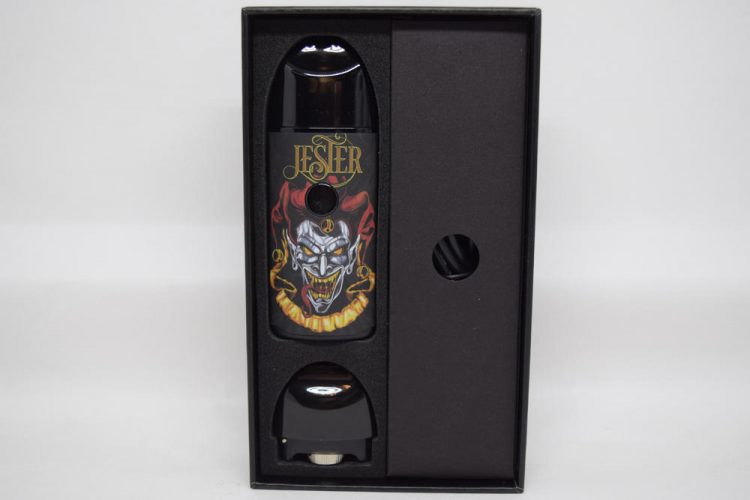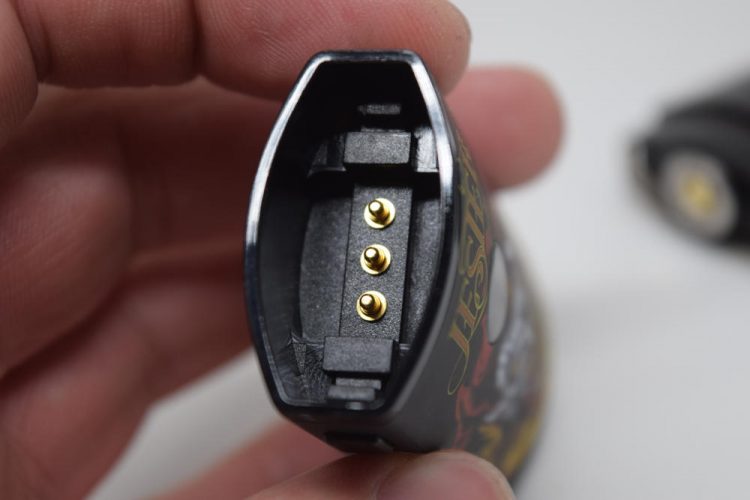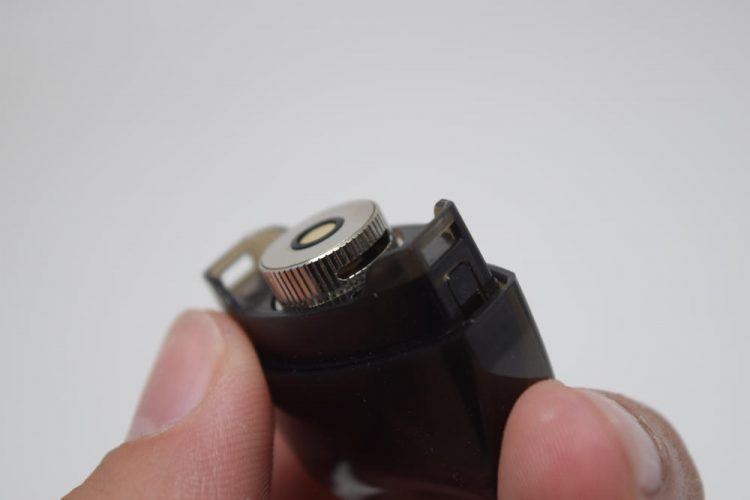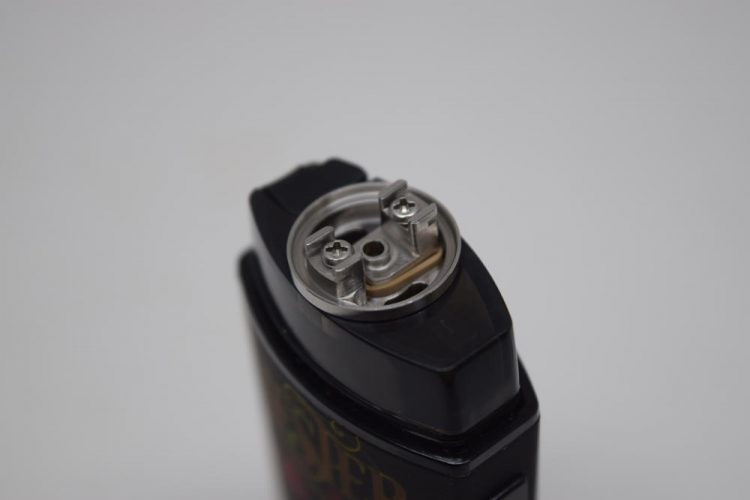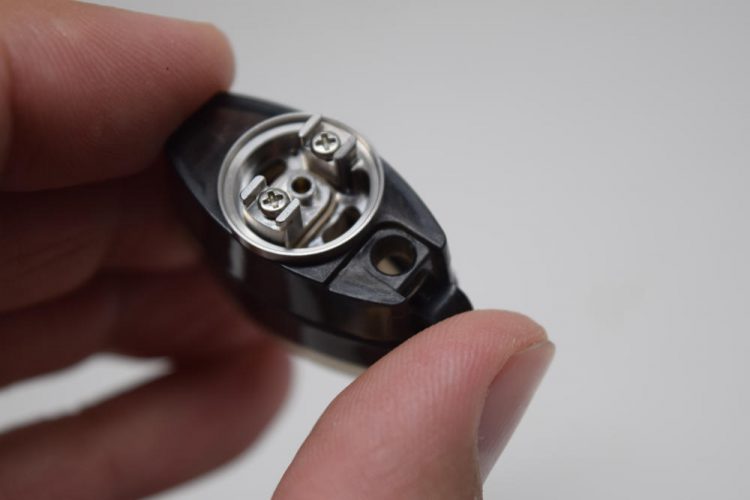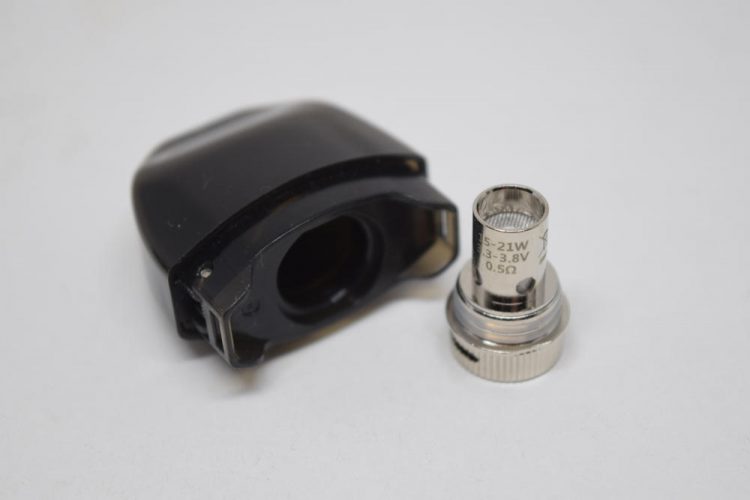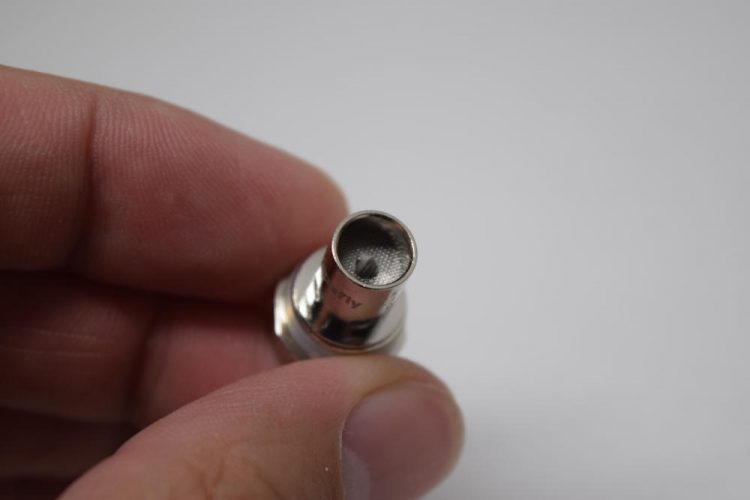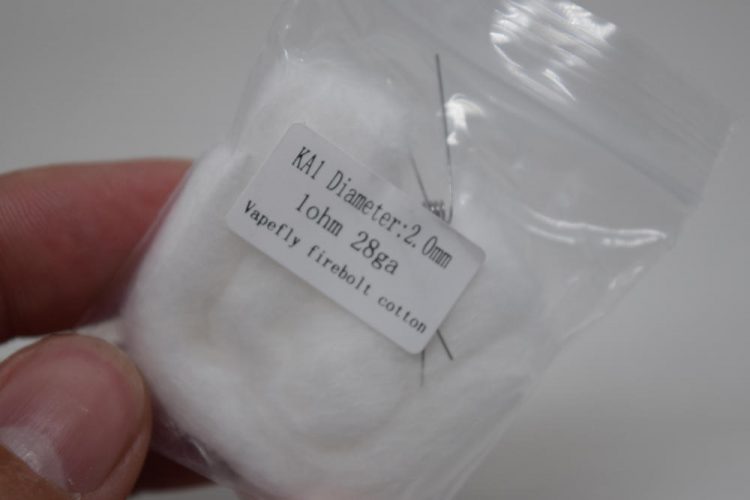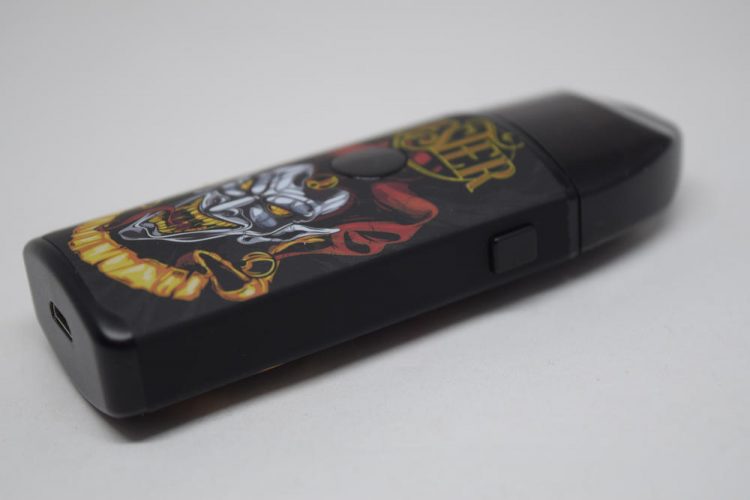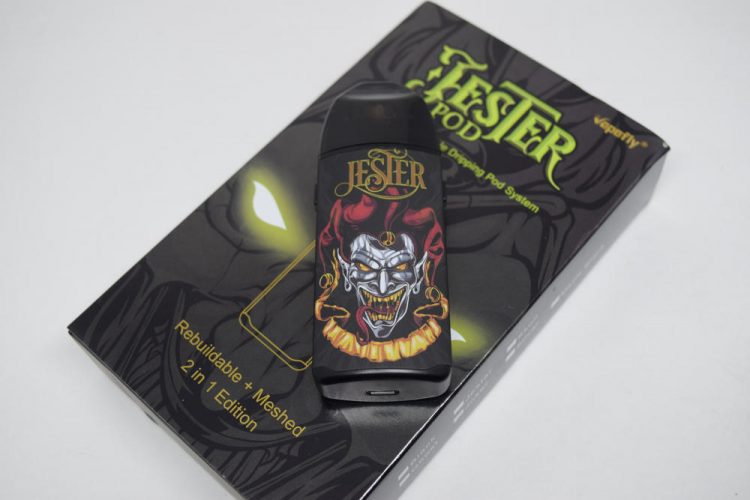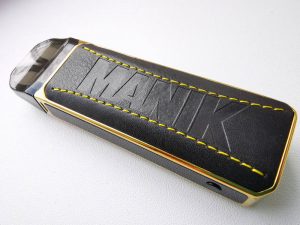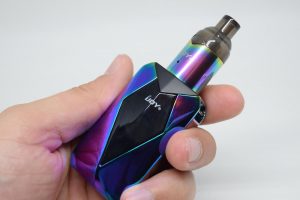Vapefly Jester Review
Even if you’ve never vaped before, you’ve probably heard about pod systems. If you’re a vaper, you’ve probably heard about pod mods, but have you ever heard about rebuildable pod systems? They’re a whole new breed of vape pods, and they’re not for everyone, but if you like tinkering with coils and saving money on disposable mods, you may want to look into them. Today we’re looking at one of the newest and most interesting rebuildbale pod systems on the market, the Vapefly Jester:
A Look at the Contents
My last and only experience with a Vapefly product was last year, when I reviewed the tiny Vapefly Pixie RDA. Other than that, I had no information about the company. But there was something about the Jester that caught my eye. I had received about a dozen new samples for review, but there was just something about one black, pearlescent box that drew my attention. The green, fairytale-style font, the creepy jester face in the background, its neon green eyes, it was very different than all the other normal boxed I had in front of me. So definitely kudos to whoever design this packaging, it rocks!
Inside the box, we have the cool-looking Jester vape pod, a spare pod, a user manual, and a smaller box containing a micro-USB charger and a bunch of accessories you normally expect to find in an RDA/RDTA kit, not a pod system kit. But then again, the Vapefly Jester is not your average vape pod.
Interestingly, the back of the box doesn’t feature a list of contents, but you will find a list of the device’s main features, as well as technical specifications and information on the manufacturer.
Design and Build Quality
At first glance, the Vapefly Jester doesn’t have the most intriguing design. Yes, there is a menacing jester staring at you with evil eyes from both sides of the device, but in terms of shape, it’s pretty classic, and reminiscent of other devices I’ve tested recently, like the VooPoo Find S Trio. It measures 91mm x 33mm x 18mm, and is made primarily of plastic, with a rubberized finish on the battery casing. You would think the plastic body feels cheap, but it really doesn’t. I don’t know if it’s the rubberized exterior or the weight of the battery, but the Jester actually feels pretty nice in the hand.
The Vapefly Jester is a manual pod system, which means you have to press a fire button to activate the battery each time you want to vape. The round power button is located in the middle of the mod and is almost flush with the mod, protruding by only a hair. But you’ll also notice a couple of smaller buttons on the narrow sides of this pod system, which, when pressed, release the pod so it can be removed.
Unlike most vape pods, the Jester doesn’t rely on magnets to keep the pods in place, instead relying on a mechanical locking system that looks much more reliable, at least at first glance. Once the pod is inserted, it locks in place via a couple of plastic notches, and can only be released when the two small buttons on the mod are pressed simultaneously. It’s pretty ingenious, and a breath of fresh air.
One of the coolest things about this device is that you have two totally different style of pods. They may look similar on the outside, but on the inside they couldn’t be more different. One of them features removable coil-heads and bottom airflow adjustment, while the other features a built-in RBA that allows you to build and use your own wire coils. It’s a lot like the Smoant Pasito in that sense, only the Jester base, while still very small in comparison to a standard RDA base, looks much easier to build on.
Let’s start with the replaceable coil-head pod. To remove the coil, simply grab on to the base of the coil sticking out from the pod and pull it out, it’s that easy. Now, putting it back in is the tricky part, as you have to align the base of the coil-head with the shape of the slot it goes into, which is easier said than done. The coil-head base is not perfectly round, and you have to align the slightly flattened edges with the edges of the slot, so the that the coil-base reaches into the pod a bit. Of it’s not aligned correctly, the pod will not fit into the mod, and you won’t be able to do it.
The thing is you’ll figure out how to insert the coil-head eventually, but Vapefly could have made things a lot easier by adding a more obvious marker on the base to help you align it easier. It’s not the end of the world, but it could have definitely been done a little better. Still, there are things I like about this style of pod. First of all, the airflow adjustment ring at the bottom of the coil-head works very well, allowing you to easily switch from mouth-to-lung to direct-lung mode.
The filling mechanism is pretty cool as well, this particular pod style features top-filling, and to access the fill port you first have to push a little button on the side of the mod and at the same time flip the top of the pod over. You can see the spring latch on one side of the pod, and the small square button on the opposite one. The fill port is sealed with a rubber cap, but is otherwise large enough to fit most styles of bottles.
But the thing you’re probably more interested in is the rebuildable pod, the one with the integrated build deck. It’s definitely an interesting concept, but one that probably won’t see much success outside the community of builders, the vapers who actually enjoy building coils, cutting leads, wicking cotton, etc. It’s a bit of a hassle for the causal vaper, let alone fresh ex-smokers, but they have plenty of simplistic pod systems to choose from, plus they can always use the mesh coil pod.
To expose the build deck, you must first yank the mouthpiece off the pod. Its pressed fit onto the bottom section, so you’ll have to put some muscle into it. Now that you have access to the base, you can either build your own micro-coil, or use on of the two 1Ω coils included in the kit. Installing them is not the easiest thing in the world, because the base and the Philips-head screws are so tiny, but if you have a bit of experience installing coils, you’ll be ok. I personally went for the stock coils and cotton that came with the kit, and I’ve been pretty happy with the performance. Obviously, you can experiment with different wires and resistances, but you can only do so much experimenting because of the limited power output of the device.
One thing you should be extra careful about is clipping the leads of the coil as short as possible, as they can make contact with the metallic bell on the inside of the mouthpiece and cause a short-circuit. It hasn’t happened to me, but I’ve seen other people posting about it online, so I thought I’d let you know. Also, when using the rebuildable pod, I don’t recommend you leave it laying horizontally for too long, as it will most likely start too leak.
The rebuildable pod is ok, but it has its limitations. For example, the wicking slots are very small, there’s no airflow control like on the other style of pod, and there is no way to check the resistance of your coil, as you would on a regular RDA. Still, having what is essentially an RDTA pod does have its advantages. The flavor is much better than from a coil-head, even a mesh one, and the cost is substantially smaller. Instead of throwing away a whole pod or a coil-head, all you have to do is dry burn your coil or just use a bit more cheap wire.
Battery Life and Performance
The Vapefly Jester pod system features a built-in 1,000mAh battery, which should last most users a day, or close to that, depending on how much they vape and the selected power output. The Jester has three available power modes, which you can browse through be pressing the fire button three times in rapid succession. When the power button lights up purple, the Jester will output 3.3 volts, when the color switches to blue, it puts out 3.8 volts, and green means the full 4.2 volts. However, for safety reasons, the last setting is only available for the rebuildable pod, and only with coils in a certain resistance range.
The battery capacity of this device is among the best I’ve seen from a pod system, but it still isn’t enough, you can also use it as a passthrough as well, meaning you can vape while the device is charging. To be honest, it’s not the safest thing in the world to do, but I for one have always been a big fan of this feature, so it’s always a plus in my book.
One thing the Vapefly Jester is missing is a proper battery life indicator. Right now, the LED light embedded in the fire button lights up according to what power output you’ve selected, and only flashes red ten times when it’s time to recharge. But, as far as I can tell, there’s no way to tell when you’re about to run out of battery, which is kind of strange. Still not a big deal, as this device has plenty of pros, enough to dismiss small design flaws like this one.
Performance wise, I have to admit that the Vapefly Jester turned out to be a pleasant surprise. Having only tested one Vapefly product before, and considering it’s not the most popular brand, I wasn’t expecting too much from this pod system. But it turned out to have all the latest features in the vape pod sector, as well some rather ingenious locking and filling systems, which I for one haven’t seen on other pod systems before.
I wasn’t all that excited about the rebuildable pod, to be honest, simply because I would rather use a true RDTA or RTA than something this tiny, but a lot of people are raving about it and for good reason. It offers great flavor, and it’s a lot cheaper to use in the long run. So as long as you don’t mind the small size of the RBA, you’ll be happy with it. I do wish it had adjustable airflow, though, as right now you’re stuck with whatever air gets in.
The replaceable coil-head pod was my favorite of the two. It’s very easy to use, convenient, it has adjustable airflow, and the mesh coil-head actually performs surprisingly well. At 0.5Ω, it’s not the most ideal for mouth-to-lung, but you can tweak the airflow to make it work. But if you really want the best MTL experience, there’s also a 1.2Ω coil-head available. Sadly, that comes included in the Meshed Edition, not the Rebuildable one I got for this review, but you can also buy it separately.
I’ve been using the Vapefly Jester for five days, and to be honest I’ve really been enjoying it. The device works as advertised, having variable power output is always nice, the pods cater to different style of vaping, and the battery life is fantastic.
Conclusion
Even though it faces some very steep competition in the rebuildable pod system market, the Vapefly is surprisingly early to the party, at least for a relatively small manufacturer, and its Jester pod has plenty of time to establish itself as the device to beat. Right now I see it going head to head with the Smoant Pasito, and even surpassing it in the RBA department, as it has the easier design to work with. Time will tell if the Jester can surpass its competitors, but I definitely give it a fighting chance. It’s a solid device, and one that I see myself using for a while going forward.
The Vapefly Jester was sent to me directly by Vapefly, for the purpose of this review.


